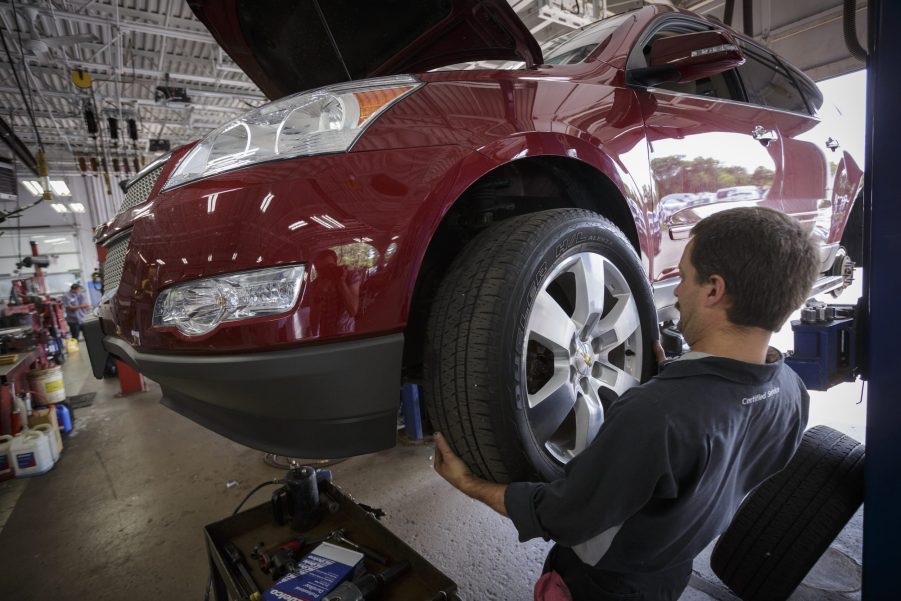
How Long Do Tires Last?
Ownership brings extra responsibilities, and vehicle ownership is no different. Owners will periodically need to replace the tires on their vehicles, but when can you expect to need to do that? Here’s a look at how long tires generally last, how maintenance can make them last as long as possible, and how you’ll know it’s time to make a purchase.
How long you can expect tires to last on average
The Federal Highway Administration has said that Americans drive 14,000 to 15,000 miles each year on average. Dan Zielinski, a spokesman for the U.S. Tire Manufacturers Association (USTMA), told Car and Driver that most new tires sold today will last about 60,000 miles if drivers maintain them and don’t drive aggressively. Doing the math shows that on average, new tires should last about four years.
However, there is variation. Zielinski said, “Some manufacturers offer a warranty as high as 80,000 miles or more, reflecting confidence in that particular product’s longevity based on its engineering, technology, and design. Other tires may be built to provide 30,000 miles of service.” There are also some high-performance components that wear out in less than 15,000 miles when used aggressively.
To estimate how long your own tires may last, look for the mileage listed in the warranty of the make and model of what you have. Divide that number by the number of miles you drive each year. The result will be the approximate number of years they should last starting from when they were new. If you live in a part of the country where you use winter tires, then your regular tires should last a bit longer since they get used for fewer miles each year.
Even without lots of driving miles, tires do expire. Car and Driver recommends inspecting them by the time they’re six years old and replacing them when they’re 10 years old, even if they don’t seem worn. A code on the tire’s sidewall will let you know how old it is. For wheels made after 2000, the last two digits of the TIN code will give the last two digits of the year, according to Car and Driver.
How to go about maintenance
Properly maintaining your tires will help them last as long as possible. Keeping the recommended air pressure will help them wear more evenly. It’s recommended to check the pressure each month.
To find the recommended pressure, look in the vehicle’s doorjamb or owner’s manual. The pressure can be checked using a handheld tire-pressure gauge, which costs about $10. Tire shops will often be willing to check the tire pressure for you. While gas station air pumps sometimes check the pressure, these don’t tend to be accurate. If you’re checking the pressure yourself, check when the tires are cold and the vehicle hasn’t been driven for several hours.
In addition to pressure, it’s useful to have your mechanic balance and align your tires and wheels. A balance machine spins the tires and wheels to check for imbalance. The mechanic can then add weight to the right spots to correct the balance. The mechanic can also align the wheels to the correct angles to make sure the vehicle is tracking straight.
Doing your own rotations or asking your mechanic to can also help them to last longer. Front-wheel-drive vehicles put more wear on their front tires, while rear-wheel-drive vehicles wear the rear ones more. The front and rear tires can be switched to even out the wear. All-wheel-drive vehicles also sometimes benefit from rotations, and the owner’s manual likely specifies how they should be rotated. The USTMA recommends getting a rotation about every 5,000 to 8,000 miles.
How to tell when you need new tires
Check the tread to see when it’s worn out and no longer safe. When the tread is reduced to a depth of 2/32 of an inch, then it needs to be replaced, according to the National Highway Traffic Safety Administration (NHTSA). Many tires include wear bars to help show when the tread has gotten down to an unsafe level. They start making a noise when it’s worn down.
Another way to check tread is with a penny. Insert the penny into the tread with Abraham Lincoln’s head pointing down. If the tread covers part of Lincoln’s head, then they’re still good. If you can see the top of his head, then they should be replaced. Tire Pros recommends checking multiple spots on each wheel in case there’s uneven wear.
When you do need to buy new tires, if the warranty hasn’t yet expired, you may be able to get a prorated price from the maker on the same brand of tires, mentions Zielinski.


